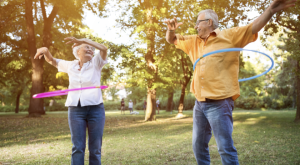6
Section One: The Fundamentals
A) Keywords
Exercise 1:
Provide a brief definition of one of the padlet keywords for this week.
| “The Third Age” is a term used to describe the period of life after retirement but before serious physical decline. It’s seen as a time for personal growth, staying active, and enjoying hobbies, travel, or even sports. Instead of viewing aging as just slowing down, this stage focuses on independence and fulfillment. However, not everyone gets to experience it the same way, things like money, health, and social support make a big difference in how people navigate this phase of life.
|
B) The Social Significance of Aging in Sport
Exercise 2: Notebook Prompt
How is old age popularly represented today? Find an image online that you think exemplifies one defining attitude towards old age and paste in your notebook below with a brief explanation of what this image means to you.
| This image represents a shift in how we view aging, rather than seeing old age as a time of decline, it highlights strength, independence, and vitality. It challenges stereotypes by showing that older adults can remain active, engaged, and full of life. To me, it’s a reminder that aging doesn’t mean slowing down but can be a time of new opportunities and continued growth
. |
Exercise 3: Notebook Prompt
What does the article (referencing another study by Dionigi) mean by its statement that sport can help aging people to simultaneously “accept and resist the ageing process” (572)? Respond by audio or text and find paste two images sourced online into your notebook showing how sport might help aging people to both accept and resist the aging process.
| The article suggests that sport enables aging individuals to both accept and resist the aging process by allowing them to acknowledge their physical limitations while simultaneously challenging societal stereotypes about aging. On the one hand, engaging in sports helps older individuals recognize the natural effects of aging, such as decreased strength or endurance. On the other hand, participation in physical activities enables them to resist aging by staying active, maintaining a sense of identity, and proving that age does not necessarily equate to frailty or inactivity.
|
Exercise 4: Notebook Prompt
Who are the groups less likely to have extensive opportunities to take part in sports, according to Pike? How does privilege factor into aging and sport? (200 words max)
| According to Elizabeth Pike, groups that are less likely to have extensive opportunities to participate in sports include older adults, women, individuals with disabilities, and those from lower socioeconomic backgrounds. Structural barriers such as financial constraints, social stereotypes, and a lack of accessible facilities contribute to their exclusion. Additionally, aging is often associated with physical decline, which reinforces the perception that sports are primarily for younger individuals.
|
Exercise 5: Padlet Discussion
Why do you think age discrimination is “reported more than any form of prejudice” with older people presented as a threat to social values and interests? Feel welcome to use video in your responses. Paste your comments (or transcript of your video) below!
| Age discrimination is often reported more than other forms of prejudice because aging is universal, everyone experiences it, making it a shared but often stigmatized process. Society tends to value youth, productivity, and innovation, which can lead to negative stereotypes about older people being fragile, resistant to change, or economically burdensome. Older individuals are sometimes portrayed as a threat to social values and interests because they challenge dominant cultural ideals of independence and efficiency. In workplaces, they may be seen as less adaptable or technologically skilled, and in healthcare, they are sometimes perceived as requiring more resources. Additionally, media representations often frame aging as something to be fought rather than embraced, reinforcing discrimination against older adults in both subtle and explicit ways.
|
B) Older Women and Sport
Exercise 6: Notebook Prompt
What differences do you see in these ads? Which one is more inclusive? How is age represented or not represented in each? Answer these questions in your notebook.
| The most noticeable difference between the first and second ad was that the second ad was clearly designed for a female audience, while the first ad aimed to be more gender-inclusive. Both ads featured a diverse range of able-bodied and disabled individuals, which contributed to their overall inclusivity. However, I found the Nike ad to be more inclusive because it represented people of various genders and abilities rather than focusing on a single demographic. Age was present in both ads, but it was not a central focus. While the individuals shown were likely of different ages, there wasn’t enough variation to clearly distinguish anyone as significantly older or younger. The only explicit representation of age appeared in the second ad, which featured a mother and her baby, emphasizing a specific stage of life rather than a broad range of ages.
|
Exercise 7: Notebook Prompt
In her article, “Assessing the sociology of sport: On age and ability,” Elizabeth Pike references a “trend towards a ‘feminisation of ageing’, with many women living longer than men” (573). Do you agree that aging has been “feminized” in this way? How? Answer these questions in your notebook.
| Yes, I agree that aging has been feminized. Since women tend to live longer than men, aging is often framed in terms of societal expectations around appearance and vitality. Older women face greater pressure to maintain a youthful look, and there is more focus on age related health issues specific to women, such as menopause and osteoporosis. These gendered expectations shape how aging is experienced and represented for women..
|
Section Three: Module Mini Assignment
| The Peterborough Pickleball Debacle is a growing controversy over public space, aging, and urban priorities. At the center of this issue is the city’s $4.4 million plan to redevelop Bonnerworth Park into a pickleball hub with 16 courts and parking lots, causing public backlash due to environmental concerns, noise pollution, and lack of consultation (Singh, 2023, Johnston-Lindsay, 2023). Although the infrastructure is presented as benefiting the community and promoting wellbeing, particularly for older adults, critics argue that it prioritizes a limited recreational focus at the expense of open, multi purpose green space. (Singh, 2024). While there are no direct criticisms of seniors, Anselmi depicts them as a politically influential group whose noisy sport interferes with others’ use of shared space, suggesting an attitude of entitlement. (Anselmi, 2023) This issue mirrors the ageist framing that Pike addresses, where older adults are often either praised for their physical activity and engagement in structured forms of recreation, or depicted as a burden to society. Pike critiques how aging is often viewed through a neoliberal lens, where older adults are expected to stay physically active, engaged in their communities, and productive in ways that fit with market-driven values (Pike, 2015). In the case of the pickleball players in Peterborough, their push for designated courts fits into this way of thinking, where staying active in structured activities is seen as important, but it also creates generational tensions. The city’s focus on improving recreational infrastructure reflects this approach, putting more value on organized activities than on informal, community-centered uses of public space. Pickleball then becomes a symbol of how public space is allocated competitively, where older adults’ presence in public relies on their ability to fit into neoliberal ideals of managing their own health and being active in civic life. So, while the conflict seems to be about urban planning, it’s really about deeper issues of how older people are represented and how public spaces are being privatized under the idea of promoting community wellbeing.
Anselmi, A. (2023, August 16). Peterborough pickleball paves park. The Narwhal. https://thenarwhal.ca/opinion-peterborough-pickleball-paves-park/
Johnston-Lindsay, S. (2023, September 12). Rally planned for Sept. 16 as group expressed more concerns. Save Bonnerworth Park. https://savebonnerworthpark.ptbo.org/wp-content/uploads/sites/2/2024/09/Rally-planned-for-Sept.-16-as-group-expressed-more-concerns.pdf
Pike, E. C. J. (2015). Assessing the sociology of sport: On age and ability. International Review for the Sociology of Sport, 50(4–5), 570–574. Singh, R. (2023, August 8). Pickleball courts spark controversy in Peterborough’s Bonnerworth Park redevelopment. The Conway Bulletin. https://theconwaybulletin.com/news/usa-pickleball-news/65390/pickleball-courts-spark-controversy-in-peterboroughs-bonnerworth-park-redevelopment/
|




